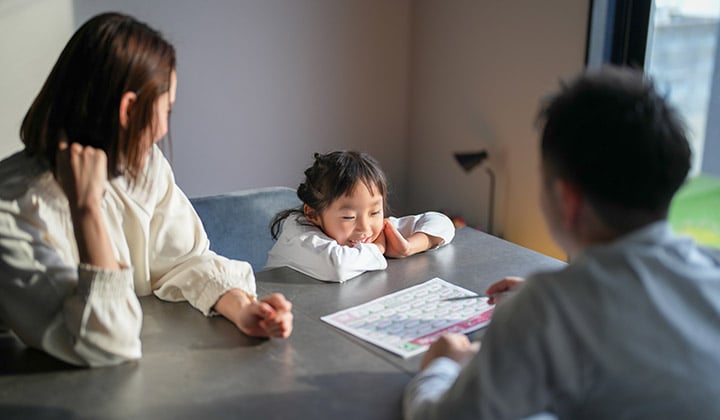Get updates
Have a parenting hack to share? Or a topic you'd like to see?
Family meetings: A simple way to stay connected

Life gets busy. Between school, sports, work and everything else, it’s easy for families to feel out of sync. That’s where family meetings come in! They give everyone a chance to talk, plan and feel heard. You don’t need a fancy setup. Just a little time, a comfy space and a plan. We talked to a few families in our community to learn how they tackle meetings – frequency, agenda and more – to give you ideas for your family!
Why family meetings matter
Family meetings help everyone know what’s coming up. They also help kids feel like their voice matters. When families talk together, they work better together. By getting everyone on the same page and making them feel a part of conversations – no matter how big or small – your family can be a well-oiled machine.
How to get started
Before the meeting, let everyone know it’s coming. Pick a quiet and comfy spot like the backyard or living room. If you have younger kids, snacks can help (because, duh). One family used M&Ms to keep little hands busy while they were talking.
For the most part, try to avoid phones or devices unless someone needs to add something to the calendar. But – you know your family best. If your kids can communicate better by having something to play mindlessly, that’s OK, too!
If the topic is hard or emotional, make sure everyone feels safe. Favorite blankets, stuffed animals or just a calm space can help.
After-dinner check-in
A popular time to “schedule” your meeting is after dinner, particularly on Sunday evenings. It’s a natural time to go over the week’s schedule, events, car needs, jobs and social gatherings. Plus, it gives everyone a chance to get on the same page so there are no last minute “I didn’t know we had that!” surprises.
You can also have a format to discuss each person’s highs and lows of the week. One family shared a format where, before they start, everyone at the table — parents, kids, even guests — shares 3 things:
- One good thing (called a rose)
- One not-so-good thing (called a thorn)
- Something they’re excited for (called a bud)
Or a funny version:
- A poopsicle (the bad thing)
- A popsicle (the good thing)
- A dreamsicle (the exciting thing)
This helps everyone connect and have a chance to feel heard.
Sample family meeting agenda
Here’s a simple plan you can follow:
1. Check-in (5–10 minutes)
- Do Rose, Bud, Thorn or Poopsicle, Popsicle, Dreamsicle
- Ask how everyone’s feeling
- Remind everyone: no devices (unless you have exceptions)
2. Calendar and schedule (10–15 minutes)
- Go over school days off, sports, appointments and holidays
- Add events to a shared calendar
- Use colors for each person
3. Chores and jobs (5–10 minutes)
- Talk about who’s doing what for the week
- Switch things up if needed
- Set 1-2 goals for the week
4. Planning and decisions (10–15 minutes)
- Talk about birthday parties, weekend plans or vacations
- Let kids vote or share ideas
5. Open floor (5–10 minutes)
- Let anyone bring up something they want to talk about
- Help quieter kids speak up with notes or prompts
6. Wrap-up (5 minutes)
- Go over what was decided
- Give everyone a small task or goal
- Say thank you to everyone for being part of the meeting
More things you can cover
Remember – this is your family meeting. You can customize it to work best for your family and situation! Consider discussing things like:
- Meal plans
- Homework
- Teacher emails
- Permission slips
- Recurring issues and plans to solve
One mom stated that, as her kids get older, they manage their own schedules and appointments more and more (plus they use a display in the kitchen to track calendars, reducing the need for frequent meetings).
When they do have family meetings, it’s usually for big decisions like planning a vacation, dividing up responsibilities or even getting a new pet or moving houses. She has found being collaborative on these things helps everyone in the family feel heard, respected and valued.
Say thank you
Always end with a thank you. Even if the meeting was about something fun, it helps everyone feel like they matter.
If the topic was hard, you can follow up with a note in a lunchbox or on the bathroom counter. Say something like, “Thanks for being part of the meeting. I know it was tough but I’m proud of how we handled it.”
Family meetings don’t have to be perfect. They just need to be real. With a little planning and kindness, they can help your family feel more connected and ready for the week ahead.
